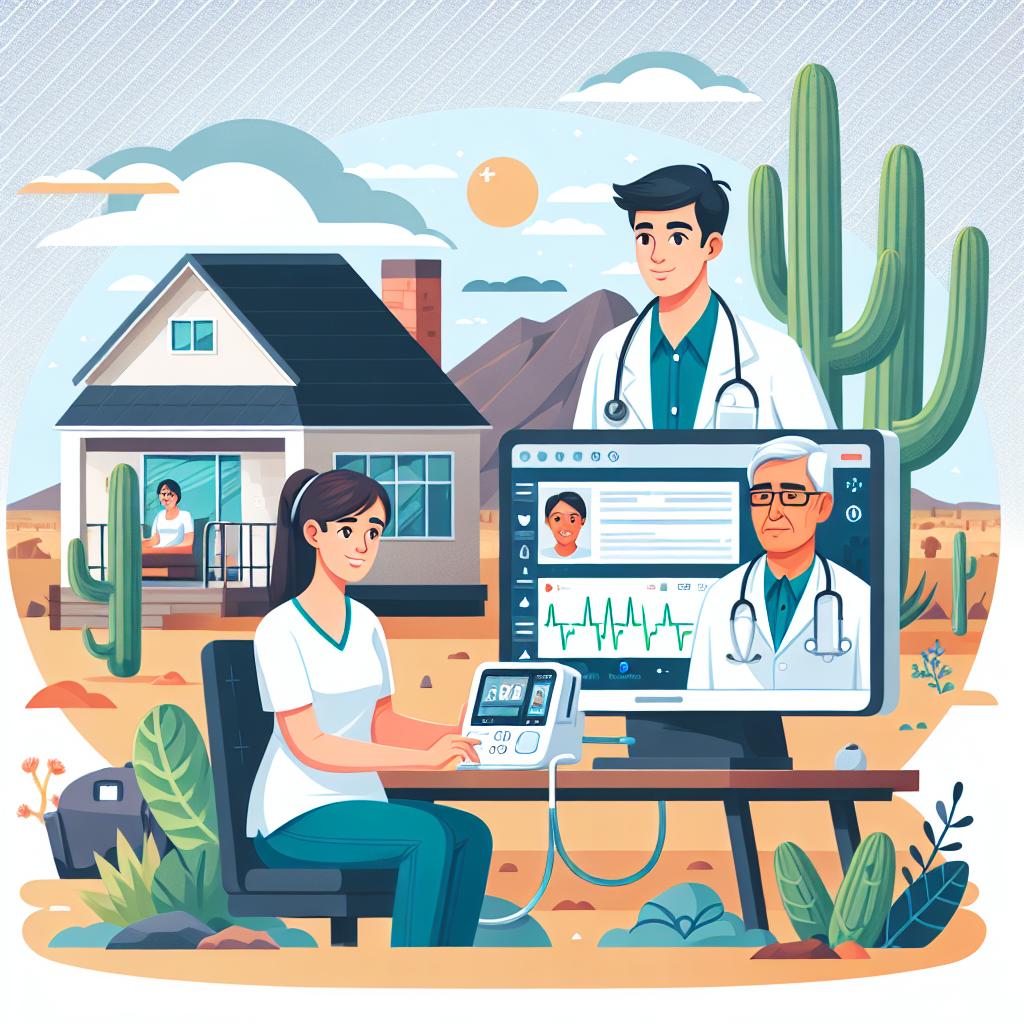Arizona Agency Enhances Home Health with Telehealth and Remote Patient Monitoring

In recent years, the integration of telehealth and remote patient monitoring (RPM) has revolutionized the healthcare landscape, offering innovative solutions to traditional challenges. Arizona, a state known for its diverse population and vast rural areas, has been at the forefront of adopting these technologies to enhance home health services. This article delves into how an Arizona agency is leveraging telehealth and RPM to improve patient outcomes, reduce healthcare costs, and increase accessibility to care. We will explore the benefits, challenges, and future prospects of these technologies in the context of home health care.
The Rise of Telehealth and Remote Patient Monitoring in Arizona
Telehealth and remote patient monitoring have gained significant traction in Arizona, driven by the need to provide efficient and accessible healthcare services across the state. The COVID-19 pandemic acted as a catalyst, accelerating the adoption of these technologies as healthcare providers sought to minimize in-person visits and reduce the risk of virus transmission.
Arizona’s unique geographical and demographic characteristics have made telehealth and RPM particularly valuable. With vast rural areas and a significant portion of the population living in remote locations, accessing healthcare services can be challenging. Telehealth bridges this gap by allowing patients to connect with healthcare providers from the comfort of their homes, eliminating the need for long-distance travel.
Moreover, Arizona’s aging population has increased the demand for home health services. Telehealth and RPM offer a viable solution by enabling continuous monitoring of patients’ health conditions, allowing for timely interventions and reducing hospital readmissions. This is particularly beneficial for managing chronic diseases such as diabetes, hypertension, and heart failure, which require regular monitoring and management.
Statistics from the Arizona Department of Health Services indicate a significant increase in telehealth utilization over the past few years. In 2020 alone, telehealth visits in Arizona increased by over 1,000%, highlighting the growing acceptance and reliance on these technologies.
Case Study: Banner Health’s Telehealth Initiative
Banner Health, one of Arizona’s largest healthcare systems, has been a pioneer in implementing telehealth and RPM solutions. Their telehealth initiative, known as Banner Telehealth, has been instrumental in expanding access to care across the state.
Banner Telehealth offers a wide range of services, including virtual consultations, remote monitoring, and tele-ICU services. The program has been particularly successful in managing chronic conditions, with patients reporting improved health outcomes and increased satisfaction with their care.
One notable success story is the use of RPM for heart failure patients. By equipping patients with remote monitoring devices, Banner Health has been able to track vital signs such as blood pressure, heart rate, and weight in real-time. This data is transmitted to healthcare providers, who can intervene promptly if any abnormalities are detected. As a result, hospital readmissions for heart failure patients have decreased by 30%, demonstrating the effectiveness of RPM in managing chronic conditions.
Benefits of Telehealth and Remote Patient Monitoring in Home Health
The integration of telehealth and RPM into home health services offers numerous benefits for patients, healthcare providers, and the healthcare system as a whole. These technologies have the potential to transform the way healthcare is delivered, making it more patient-centered, efficient, and cost-effective.
Improved Access to Care
One of the most significant advantages of telehealth and RPM is improved access to care, particularly for individuals living in rural or underserved areas. In Arizona, where many residents face geographical barriers to accessing healthcare services, telehealth provides a lifeline by connecting patients with healthcare providers regardless of their location.
For example, a patient living in a remote area can have a virtual consultation with a specialist located hundreds of miles away, eliminating the need for travel and reducing the associated costs and time. This is especially beneficial for individuals with mobility issues or those who require frequent follow-up appointments.
Enhanced Patient Engagement and Satisfaction
Telehealth and RPM empower patients to take an active role in managing their health. By providing patients with access to their health data and enabling them to communicate with healthcare providers remotely, these technologies foster greater patient engagement and satisfaction.
Patients can monitor their health conditions in real-time, track their progress, and receive personalized feedback from healthcare providers. This level of engagement encourages patients to adhere to treatment plans, make informed decisions about their health, and ultimately achieve better health outcomes.
Furthermore, telehealth offers convenience and flexibility, allowing patients to schedule appointments at their convenience and avoid the hassle of commuting to a healthcare facility. This convenience is particularly valuable for individuals with busy schedules or those who require frequent medical consultations.
Cost Savings for Patients and Healthcare Providers
Telehealth and RPM have the potential to significantly reduce healthcare costs for both patients and providers. For patients, virtual consultations eliminate the need for travel, reducing transportation costs and time away from work or other responsibilities. Additionally, remote monitoring can help prevent costly hospitalizations by enabling early detection and intervention for health issues.
For healthcare providers, telehealth reduces the need for physical infrastructure and resources, allowing them to serve more patients with fewer overhead costs. By streamlining operations and optimizing resource allocation, providers can deliver high-quality care more efficiently and cost-effectively.
Moreover, telehealth can help reduce the burden on emergency departments by providing an alternative avenue for non-emergency consultations. This not only alleviates pressure on healthcare facilities but also ensures that emergency resources are available for those who truly need them.
Challenges and Barriers to Implementation
While the benefits of telehealth and RPM are undeniable, there are several challenges and barriers to their widespread implementation in home health services. Addressing these challenges is crucial to ensuring the successful integration of these technologies into the healthcare system.
Technological and Infrastructure Limitations
One of the primary challenges in implementing telehealth and RPM is the availability of reliable technology and infrastructure. In rural areas of Arizona, where internet connectivity may be limited or unreliable, accessing telehealth services can be challenging. This digital divide poses a significant barrier to ensuring equitable access to care for all residents.
Additionally, the cost of acquiring and maintaining telehealth equipment and software can be prohibitive for some healthcare providers, particularly smaller practices or those with limited resources. Ensuring that providers have access to affordable and reliable technology is essential for the successful adoption of telehealth and RPM.
Regulatory and Reimbursement Issues
Regulatory and reimbursement issues also pose challenges to the widespread adoption of telehealth and RPM. While there have been significant advancements in telehealth regulations, particularly during the COVID-19 pandemic, there is still a lack of uniformity in policies across states and payers.
Reimbursement for telehealth services can vary significantly depending on the payer, with some insurance companies offering limited coverage for virtual consultations or remote monitoring. This inconsistency can deter healthcare providers from offering telehealth services, as they may not receive adequate compensation for their efforts.
Addressing these regulatory and reimbursement challenges requires collaboration between policymakers, payers, and healthcare providers to establish clear guidelines and ensure fair compensation for telehealth services.
Patient and Provider Acceptance
Another challenge in implementing telehealth and RPM is ensuring acceptance and adoption by both patients and healthcare providers. Some patients may be hesitant to embrace virtual consultations due to concerns about privacy, security, or the perceived quality of care.
Similarly, healthcare providers may be resistant to adopting telehealth technologies due to concerns about workflow disruptions, the learning curve associated with new technology, or skepticism about the effectiveness of virtual care.
To overcome these challenges, it is essential to provide education and training for both patients and providers, highlighting the benefits and addressing any concerns they may have. Building trust and confidence in telehealth services is crucial for their successful integration into home health care.
Future Prospects and Innovations in Telehealth and RPM
The future of telehealth and RPM in home health care is promising, with ongoing innovations and advancements poised to further enhance the delivery of care. As technology continues to evolve, new opportunities for improving patient outcomes and expanding access to care are emerging.
Integration of Artificial Intelligence and Machine Learning
One of the most exciting prospects for telehealth and RPM is the integration of artificial intelligence (AI) and machine learning (ML) technologies. These technologies have the potential to revolutionize remote monitoring by enabling more accurate and predictive analysis of patient data.
AI algorithms can analyze vast amounts of data collected from remote monitoring devices, identifying patterns and trends that may indicate potential health issues. This predictive capability allows healthcare providers to intervene proactively, preventing complications and improving patient outcomes.
Moreover, AI-powered chatbots and virtual assistants can enhance patient engagement by providing personalized health advice, answering questions, and facilitating communication with healthcare providers. These innovations have the potential to make telehealth services more interactive and responsive to patients’ needs.
Expansion of Telehealth Services
The scope of telehealth services is expected to expand in the coming years, offering a wider range of healthcare services remotely. Beyond virtual consultations and remote monitoring, telehealth can encompass services such as teletherapy, telepharmacy, and tele-rehabilitation.
Teletherapy, for example, allows patients to receive mental health counseling and support from licensed therapists through video conferencing. This is particularly valuable in areas with limited access to mental health services, providing individuals with the support they need without the need for travel.
Similarly, telepharmacy services enable patients to consult with pharmacists remotely, receive medication counseling, and have prescriptions delivered to their homes. This convenience can improve medication adherence and ensure that patients receive the necessary guidance for managing their medications.
Collaboration and Partnerships
The future of telehealth and RPM will also be shaped by collaboration and partnerships between healthcare providers, technology companies, and policymakers. By working together, these stakeholders can address the challenges and barriers to implementation, ensuring that telehealth services are accessible, affordable, and effective.
Partnerships with technology companies can facilitate the development of innovative solutions tailored to the needs of home health care. For example, collaborations can lead to the creation of user-friendly remote monitoring devices or the development of secure telehealth platforms that prioritize patient privacy and data security.
Additionally, collaboration with policymakers can help establish clear regulations and reimbursement policies that support the sustainable growth of telehealth services. By advocating for policies that promote telehealth adoption, stakeholders can ensure that these technologies continue to benefit patients and healthcare providers alike.
Conclusion
The integration of telehealth and remote patient monitoring into home health services in Arizona represents a significant advancement in healthcare delivery. These technologies offer numerous benefits, including improved access to care, enhanced patient engagement, and cost savings for both patients and providers. However, challenges such as technological limitations, regulatory issues, and acceptance barriers must be addressed to ensure their successful implementation.
As technology continues to evolve, the future of telehealth and RPM in home health care is promising. Innovations such as AI integration, expanded telehealth services, and collaborative partnerships hold the potential to further enhance the delivery of care and improve patient outcomes. By embracing these advancements, Arizona’s healthcare system can continue to lead the way in providing efficient, accessible, and patient-centered care for all residents.





